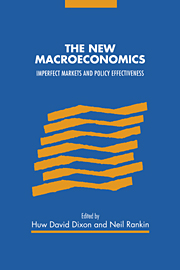Book contents
- Frontmatter
- Contents
- List of contributors
- Preface
- Acknowledgements
- Introduction
- Part I Overviews and perspectives
- Part II Goods market imperfections
- Part III Labour market imperfections
- 7 Demand uncertainty and unemployment in a monopoly union model
- 8 Efficiency wages as a persistence mechanism
- 9 Efficiency, enforceability and acyclical wages
- 10 Business fluctuations, worker moral hazard and optimal environmental policy
- Part IV Financial market imperfections
- Part V Nominal rigidities and bounded rationality
- Bibliography
- Index of authors
- Index of subjects
10 - Business fluctuations, worker moral hazard and optimal environmental policy
Published online by Cambridge University Press: 13 October 2009
- Frontmatter
- Contents
- List of contributors
- Preface
- Acknowledgements
- Introduction
- Part I Overviews and perspectives
- Part II Goods market imperfections
- Part III Labour market imperfections
- 7 Demand uncertainty and unemployment in a monopoly union model
- 8 Efficiency wages as a persistence mechanism
- 9 Efficiency, enforceability and acyclical wages
- 10 Business fluctuations, worker moral hazard and optimal environmental policy
- Part IV Financial market imperfections
- Part V Nominal rigidities and bounded rationality
- Bibliography
- Index of authors
- Index of subjects
Summary
Introduction
The main purpose of this chapter is to study the relationship between environmental and employment variables in an economy subject to worker moral hazard, and the way this relationship is affected by environmental policy. We consider two models. In model 1 (dealt with in the second section) firms face a stationary environment, while in model 2 (the third section) the (exogenous world market) prices of firms' products fluctuate randomly between a high and a low level, pOH and pOL. The main focus of the chapter is model 2, model 1 serving mainly as benchmark for the discussion of model 2.
In both models we assume that there is a worker moral hazard problem in production, in a way analogous to Shapiro and Stiglitz (1984), as workers must have incentives to put up a given total effort level, enforced through a wage exceeding the level clearing the labour market. This implies that employment in the economy in general is inefficiently low. In our set-up total effort has two components, namely output related effort, and effort that serves to reduce pollution discharges from the firm (which are assumed to be perfectly observable by outsiders). The firm can decide how a total worker effort x is to be composed of effort affecting output, y, and that affecting environmental care, z. The firm is subject to a constant unit pollution tax t, set by the government. at a given constant rate.
- Type
- Chapter
- Information
- The New MacroeconomicsImperfect Markets and Policy Effectiveness, pp. 214 - 234Publisher: Cambridge University PressPrint publication year: 1995



